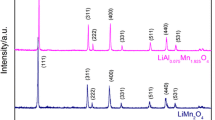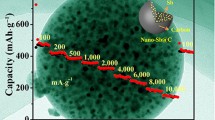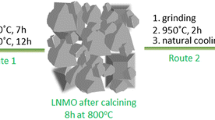Abstract
For the urgent demand of higher capacity of lithium-ion battery anode, tin pyrophosphate has attracted more and more attention because of its high theoretical capacity, cheapness, and no toxicity. However, production of stable mesoporous sphere structure and improvement of electrochemical performance remain a challenge. Here, SnP2O7 spherical particles were successfully prepared through spray drying method with SnCl4·5H2O and C2H8O7P2. Crystallization and microstructure were investigated by TG-DSC, XRD, SEM, and TEM. With the obtained mesoporous SnP2O7 particles after carbon coating, it demonstrates a high initial capacity reaching up to 1218 mAh g−1 and a significantly stable cycling performance with 620 mAh g−1 after 80 deep electrochemical cycles.
Similar content being viewed by others
Avoid common mistakes on your manuscript.
Introduction
With the rapid development of kinds of electronic products and electric vehicles, the demands of high performance rechargeable batteries are dramatically increased [1]. In the case of anode, some new materials such as silicon [2] and tin [3] have attracted much attention because of their high theoretical capacities. However, the large volumetric expansion of these materials during lithiation which leads to severe mechanical, chemical problems, seriously restricts their application [4]. To address these problems, different approaches and structure design have been proposed [5–7]. As a promising approach, introducing an inactive matrix can significantly buffer the volumetric expansion [8] and then improve the electrochemical performance. Based on it, tin pyrophosphate as a promising anode has attracted much attention [9–11].
Behm et al. [12] suggested crystalline SnP2O7 as a potential anode material for lithium batteries. However, the capacity decayed rapidly because of its low conductivity and unstable structure [13–15]. Kim et al. [16] reported that mesoporous tin phosphate/crystalline Sn2P2O7 composite exhibited a large initial charge capacity up to 721 mAh g−1 and excellent cycling stability. On the other hand, it was reported that the large extrinsic irreversible capacity from the side reactions was drastically decreased by introducing amorphous carbon coating on the surface of the anode materials [17, 18]. However, production of stable mesoporous sphere structure and improvement of electrochemical performance still remain a challenge.
Here, we demonstrate a scalable production of stable mesoporous SnP2O7 spheres through a simple spray drying method with SnCl4·5H2O and C2H8O7P2. Owning to the large specific surface area of mesoporous SnP2O7 spheres, the first discharge capacity reached 1218 mAh g−1. After conformal carbon coating, the electrodes demonstrated a stable electrochemical performance with capacity of 620 mAh g−1 after 80 deep electrochemical cycles at the upper cut off voltage of 3.0 V. The mesoporous structure SnP2O7@C mainly has three advantages below: (1) mesoporous structure provide more space for the volume expansion of SnP2O7 during cycling; (2) mesoporous structure has relatively larger surface areas which can benefit charge-transfer reaction rates; (3) a thin amorphous carbon coating can largely improve the conductivity of SnP2O7 electrode, further improving the rate performance of it.
Experimental section
Synthesis of uncoated/carbon-coated mesoporous SnP2O7
To synthesize the spherical carbon-coated SnP2O7 particles, we employed SnCl4·5H2O and C2H8O7P2 (HEDP) as raw materials. Appropriate sucrose was used as carbon source. Stoichiometric materials were dissolved in de-ionized water and stirred for 2 h at room temperature. Then, the solution was squeezed into a high temperature furnace. The precursors were attained with the droplets in the sol dried quickly at 220 °C. Calcination was conducted in the Ar atmosphere with a 3 °C min−1 heating rate to 600 °C for 10 h to get SnP2O7 particles. The final SnP2O7@C products were obtained after the furnace cooled to room temperature.
Characterization
The TG-DSC was operated on a thermal gravimetric analyzer (STA449F1, NETZSCH, Germany) under nitrogen atmosphere at a heating rate of 10 °C min−1, from room temperature to 1000 °C under N2 atmosphere. The crystalline phases and phase purity of the prepared samples were identified by X-ray diffraction (ULTIMA-3, Rigaku, Japan), operated at 40 kV and 40 mA. The morphology of powders was observed by Field-emission scanning electron microscopy (FESEM, Ultra 55, Zeiss, Germany) and transmission electron microscopy (TEM, JEM-200CX, JEOL).
Cell assembly and electrochemical tests
The electrode was prepared by mixing the active materials (80 wt.%), carbon black (10 wt.%), and PVDF (10 wt.%) in N-methyl-2-pyrrolidinone (20 wt.%). The slurry was spread onto copper foil and dried in a vacuum oven at 110 °C over 4 h. The mass loading of the electrode was ∼0.5 mg/cm2. The 2032 coin-type half cells were assembled in an Ar-filled glove box with the as-prepared mixture coated on copper foil as the working electrode and lithium foil as the counter/reference electrode. The 1-M LiPF6 solution in ethylene carbonate and dimethyl carbonate (1:1, v/v) was used as the electrolyte. The Galvano static test was conducted on electrochemical test instrument (Maccor S4000) in a voltage range of 0.01–3 V at room temperature.
Results and discussion
Figure 1a shows the TG-DSC curves of the precursor, at a heating rate of 10 °C min−1 from room temperature to 1000 °C in nitrogen atmosphere. The TG curve exhibits three obvious weight loss steps, and the DSC curve shows relevant endothermic peaks. The first step of weight loss can be ascribed to the release of the absorbed water under 180 °C. The main weight loss occurred from 260 to 320 °C could be attributed to the decomposition of the raw materials with the emission of some gas. Crystallization of the phosphate starts from 400 to 580 °C. No weight loss and no endothermic peak found above 580 °C indicate the complete crystallization. As a consequence, we choose to keep the precursors at 600 °C for 10 h to get pure SnP2O7@C material.
XRD patterns of the obtained particles are shown in Fig. 1b. Precursors obtained from spray drying exhibit no diffraction peaks as we expected. It indicates that the obtained precursors after spray drying are amorphous. Well-crystallized cubic phase SnP2O7 (ICDD-JCPDS No. 29–1352) were attained from the amorphous precursors after calcination. From the Fig. 1b, we can see that the main peaks of the obtained particles are completely corresponding to the peaks (111) (200) (210) (211) (220) (311) (222) (331) (420) (422) (250) of SnP2O7 and no impurity phase was detected on the XRD patterns, indicating that we obtain the pure SnP2O7 with a high crystallinity.
Scanning electron microscopy (SEM) characterization was performed to observe the morphology and structure of the obtained mesoporous SnP2O7 spheres. As seen from Fig. 2a, the obtained SnP2O7 exhibited exactly sphere structure and the diameter of SnP2O7 spheres ranged from hundreds of nanometers to ~5 μm. From the statistical analysis of the diameter of SnP2O7 spheres in the Fig. 2c, most of the obtained SnP2O7 spheres’ diameters were around ~1 μm. Figure 2b shows the closer observation of mesoporous SnP2O7 spheres. Some macropores in the SnP2O7 sphere were observed. To probe the pore diameter and the Brurauer–Emmerr–Teller (BET) surface area of the mesoporous SnP2O7 spheres, the nitrogen sorption characterization was also performed. As illustrated in Fig. 2d, the Barretl–Joyner–Halenda (BJH) pore diameter of the spheres was around 22 nm and BET surface area of the obtained mesoporous SnP2O7 spheres was 29.8 m2/g. The large surface resulting from the sphere structure and the mespores on the surfaces are efficient for Li+ diffusion which may lead to stable and significant electrochemical performance.
To further improve the conductivity of the SnP2O7 electrodes, we also coated the obtained mesoporous SnP2O7 spheres with uniform carbon coating. Figure 3a shows the transmission electron microscope (TEM) characterization of the synthesized SnP2O7 spheres after carbon coating. The thickness of carbon layer along the surface of SnP2O7 spheres is about ∼20 nm. The thermal analysis was probed to clarify the mass of coated carbon in the synthesized SnP2O7 @C. From the TG curve in the Fig. 3b, we can see that the mass of coated carbon on the surface of SnP2O7 spheres was ~18 %.
To evaluate the obtained mesoporous SnP2O7 spheres and SnP2O7@C as electrodes for lithium-ion battery, their electrochemical properties were systematically studied. Figure 4a shows the voltage profiles of SnP2O7 and SnP2O7 @C for the first cycle at a rate of 0.1 °C between 0.01 and 3 V (vs Li/Li+) at room temperature. The first discharge capacity of mesoporous SnP2O7 electrode was 1122 mAh g−1, but the charge capacity decreased to only 582 mAh g−1. In comparison, after carbon coating the first discharge capacity of SnP2O7@C electrode reached 1218 mAh g−1 and the charge capacity was 759 mAh g−1. It clearly illustrates that the irreversible capacity of the mesoporous SnP2O7 spheres after carbon coating can significantly be reduced. From the voltage profiles, we can also find that the irreversible capacities resulted from the irreversible reduction of Sn(IV) to Sn(0) shown by the plateau at about 1.2–1.4 V, breakdown of the phosphate phases, and some side reactions with the electrolytes during the first reduction process, which is corresponding to other groups’ results [11, 19]. Figure 4b shows the cycle performance of the both electrodes. The capacity of SnP2O7 electrode decayed rapidly, and after just 20 cycles the reversible capacity remained below 300 mAh g−1, while with uniform carbon coating the capacity remained stable above 600 mAh g−1 after 80 cycles. As seen in the Fig. 4b, though the first columbic efficiency (CE) was 62.3 %, it increased to ~99 % rapidly and from the third cycle it remained above 99.2 %. These improved performance was mainly attributed to the enhanced conductivity and buffering effect of the uniform carbon layer.
Conclusion
In summary, we have demonstrated a scalable production of stable mesoporous SnP2O7 spheres through a simple spray drying process with C2H8O7P2 and SnCl4·5H2O. The obtained SnP2O7 spheres with further carbon coating showed 80 stable deep cycling with the reversible capacity above 600 mAh g−1. We anticipate that the process in our work would provide a complementary method for production of SnP2O7 anode materials and speed up its application in lithium-ion battery.
References
Armand M, Tarascon JM (2008) Building better batteries. Nature 451 (7179):652–657
Wu H, Chan G, Choi JW, Ryu I, Yao Y, McDowell MT, Lee SW, Jackson A, Yang Y, LB H, Cui Y (2012) Stable cycling of double-walled silicon nanotube battery anodes through solid-electrolyte interphase control. Nat Nanotechnol 7(5):309–314
Tin-Graphene Anode Boosts Li-Ion Battery Capacity (2011). Chem Eng Prog 107 (9):14–14
Derrien G, Hassoun J, Panero S, Scrosati B (2007) Nanostructured Sn-C composite as an advanced anode material in high-performance lithium-ion batteries. Adv Mater 19 (17):2336 − +
Wang XJ, Zhai GH, Wang H (2015) Synthesis and electrochemical investigation of tin dioxide-based elastic hollow microspheres for lithium storage. Ionics 21(6):1533–1538
Wang LB, Kitamura S, Obata K, Tanase S, Sakai T (2005) Multilayered Sn-Zn-Cu alloy thin-film as negative electrodes for advanced lithium-ion batteries. J Power Sources 141(2):286–292
Atar N, Eren T, Yola ML, Gerengi H, Wang SB (2015) Fe@Ag nanoparticles decorated reduced graphene oxide as ultrahigh capacity anode material for lithium-ion battery. Ionics 21(12):3185–3192
Palanichamy K (2011) On the modified inverse spinel-LiCo(PO4)(x)(VO4)(1-x) as cathode for rechargeable lithium batteries. Ionics 17 (5):391–397
Gejke C, Borjesson L, Edstrom K (2003) Cycling performance and temperature stability of a tin-borate glass anode. Electrochem Commun 5(1):27–31
Ho WH, Yen SK (2005) Electrochemical synthesis of SnHPO4/H3PO3 on Pt and forming SnP2O7. Electrochem Solid St 8(10):C134–C137
Lee JG, Son D, Kim C, Park B (2007) Electrochemical properties of tin phosphates with various mesopore ratios. J Power Sources 172(2):908–912
Behm M, Irvine JTS (2002) Influence of structure and composition upon performance of tin phosphate based negative electrodes for lithium batteries. Electrochim Acta 47(11):1727–1738
Gover RKB, Withers ND, Allen S, Withers RL, Evans JSO (2002) Structure and phase transitions of SnP2O7. J Solid State Chem 166(1):42–48
Wang HT, Xiao J, Zhou ZF, Zhang F, Zhang HM, Ma GL (2010) Ionic conduction in undoped SnP2O7 at intermediate temperatures. Solid State Ionics 181(33–34):1521–1524
Lan R, Tao SW (2009) Conductivity of a new pyrophosphate Sn0.9Sc0.1P2O7 prepared by an aqueous solution method. J Alloy Compd 486(1–2):380–385
Kim E, Son D, Kim TG, Cho J, Park B, Ryu KS, Chang SH (2004) A mesoporous/crystalline composite material containing tin phosphate for use as the anode in lithium-ion batteries. Angew Chem Int Edit 43(44):5987–5990
Wang SQ, Jiang XY, GD D, Guo ZP, Jang J, Kim SJ (2011) Solvothermal synthesis of Mn2P2O7 and its application in lithium-ion battery. Mater Lett 65(21–22):3265–3268
Gao J, Jiang CY, Wan CR (2010) Influence of carbon additive on the properties of spherical Li4Ti5O12 and LiFePO4 materials for lithium-ion batteries. Ionics 16(5):417–424
Li YM, Li JH (2008) Carbon-coated macroporous Sn2P2O7 as anode materials for Li-ion battery. J Phys Chem C 112(36):14216–14219
Acknowledgments
This research was supported by the Jiangsu Province Prospective Joint Research on Pilot Project (No. BY2013072-03), a Grant for State Key Program for Basic Research of China (Nos. 2013CB632702, 2012CB921503), the National Natural Science Foundation of China (No. 11134006), a project funded by the Priority Academic Program Development of Jiangsu Higher Education Institutions (PAPD), a Project of Free Exploration funded by the National Laboratory of Solid State Microstructures, Test Foundation of Nanjing University.
Author information
Authors and Affiliations
Corresponding author
Rights and permissions
About this article
Cite this article
Wu, T., Dai, G., Qin, C. et al. A novel method to synthesize SnP2O7 spherical particles for lithium-ion battery anode. Ionics 22, 2315–2319 (2016). https://doi.org/10.1007/s11581-016-1773-3
Received:
Revised:
Accepted:
Published:
Issue Date:
DOI: https://doi.org/10.1007/s11581-016-1773-3








